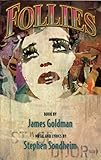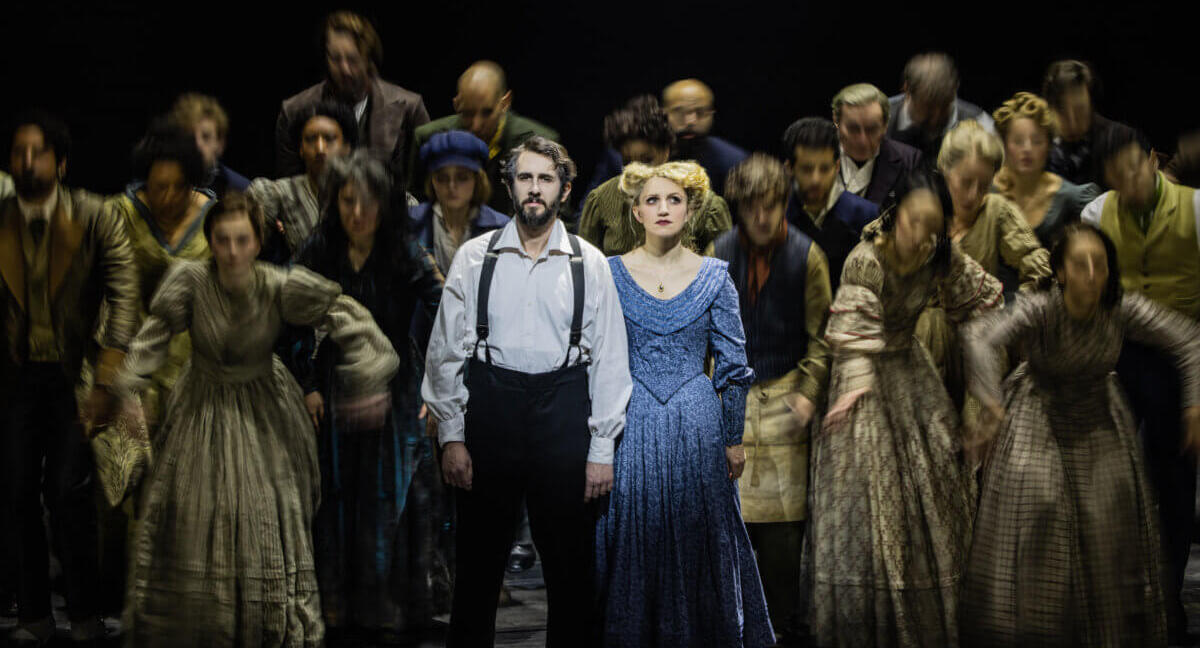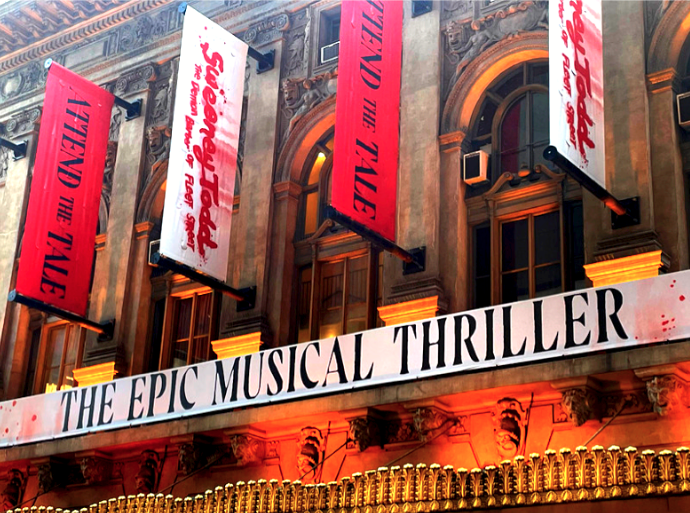There was a blizzard the night my mother went with a friend to see Sweeney Todd in March of 1979, the month it opened. When she emerged from The Uris Theatre that evening, my mother had stars in her eyes. “It was as if the world had turned upside down,” she would later tell me. She and her friend walked to the subway in a silence broken only by the crunch of snow underfoot.
After its Broadway run, Sweeney Todd went on national tour, with George Hearn replacing Len Cariou as Sweeney and Angela Lansbury (thank goodness) staying on to play Mrs. Lovett. One performance of that tour—just one!—was recorded for a televised broadcast. Because there is a record of the show’s original look and feel, its Brechtian staging and the fine-tuned direction of its actors, its overpowering orchestration and eye-popping, soul-gutting performances, every subsequent generation of Sondheim lovers has been able to experience at least a percentage of that world-flipped-upside down shock and excitement that my mother described feeling when she left the Uris Theatre that night.
In Craig Zadan’s 1994 book Sondheim and Company, Lansbury says of the production:
The thinking theater people loved it. They realized what an extraordinary piece of work it was. And the New York audiences who had come to previews and didn’t particularly like it, suddenly were told to pull up their socks, open their eyes and ears, and receive this extraordinary piece of work and give it the attention it deserved. And thank goodness they did…because sometimes, you know, sometimes you just have to educate an audience.



 My own education would soon be underway. My family bought our first VCR around 1983, and it wasn’t long before we owned a VHS copy of that televised performance. I was eight years old, and permitted to watch it in its entirety. (Parents were different then, or maybe mine just lacked judgment, but no one fast-forwarded through the throat-slitting nor the judge’s lascivious overtures toward Johanna, nor the graphic descriptions of rape; I might have spent a lot of nights sleeping on my sister’s bedroom floor as a result, but I don’t think I was permanently traumatized.) I was now destined to become a member of the Sondheim club, an annoyingly self-important and fabulously fun group of people. Soon, my sister and I had memorized the lyrics to Sweeney, as well as Company, Follies, Assassins, and Merrily We Roll Along. Which is to say: I apologize in advance. I am perhaps not the person to review a new production of Sweeney Todd that purports to be staged fairly closely to the original. In my defense, comparisons are inevitable, almost essential to any review of subsequent productions of a show that most Sondheim diehards consider his masterpiece. Being wedded to the original does at least offer a yardstick. I will try not to beat this new production over the head with it.
My own education would soon be underway. My family bought our first VCR around 1983, and it wasn’t long before we owned a VHS copy of that televised performance. I was eight years old, and permitted to watch it in its entirety. (Parents were different then, or maybe mine just lacked judgment, but no one fast-forwarded through the throat-slitting nor the judge’s lascivious overtures toward Johanna, nor the graphic descriptions of rape; I might have spent a lot of nights sleeping on my sister’s bedroom floor as a result, but I don’t think I was permanently traumatized.) I was now destined to become a member of the Sondheim club, an annoyingly self-important and fabulously fun group of people. Soon, my sister and I had memorized the lyrics to Sweeney, as well as Company, Follies, Assassins, and Merrily We Roll Along. Which is to say: I apologize in advance. I am perhaps not the person to review a new production of Sweeney Todd that purports to be staged fairly closely to the original. In my defense, comparisons are inevitable, almost essential to any review of subsequent productions of a show that most Sondheim diehards consider his masterpiece. Being wedded to the original does at least offer a yardstick. I will try not to beat this new production over the head with it.
First, some context about Sondheim and why performers in his shows must be fine-tuned actors. Let’s back up to 1943, when Rodgers and Hammerstein came on the scene with Oklahoma, and quietly blew up the conventions of musical theater. Their innovation: Realism, but something more. In their shows, characters share and explore their thoughts and feelings through song; these songs were presented not to the audience, but to one another, as a continuation of a scene rather than an interruption for a “song and dance number.” As song became an essential vehicle for onstage communication, musical theater demanded that its performers be actors as much as they were singers.
Sondheim, Hammerstein’s protege, took this innovation to another level. His songs were melodically and lyrically intricate reflections of complex thoughts and feelings. Equal parts clever and heartfelt. Forbidden Broadway, an Off-Broadway revue that parodied hit shows, teases Sondheim about his “tricky little wording,”’ but anyone with a heart can feel the manic terror in “Not Getting Married Today,” from Company; the wistful nostalgia in “Waiting Around For the Girls Upstairs,” from Follies; the poignant pathos of the misguided outsider in “How I Saved Roosevelt,” from Assassins.
And then there’s Sweeney Todd, a show that requires—in a single song, “Epiphany”—that the lead actor swing back and forth between extravagant joy in vengeful serial murder and desperate keening over the loss of his wife,whom he presumes dead, and daughter, now Judge Turpin’s ward and prisoner. At heart, this self-proclaimed “musical thriller” is also a tragedy, and the hero’s fatal flaw is his pessimism. In “Epiphany,” Sondheim illustrates how trauma and despair can destroy conscience and fracture identity beyond repair; the song should be a tour de force that conveys a man’s rapid descent into madness.
Which brings me to the Sweeney Todd revival now playing at the Lunt-Fontanne Theatre, directed by Thomas Kail and starring Josh Groban as the titular demon barber and Annaleigh Ashford as his admiring conspirator, Mrs. Lovett.
Josh Groban seems like a very nice man. He has a nice enough voice, and a handsome enough face. He has tons of passion for this particular musical, having spearheaded its return to Broadway. What he does not have is the power to pull off the acting it requires, nor the gravitas to make you squirm and shake in your seat. Meanwhile, Annaleigh Ashford is a confident performer—she has reason to be. She has a strong, reliable voice, a beautiful face, and excellent, if conventional, timing. In part, it is this very confidence that is her downfall in Sweeney.
When Sweeney, and the audience, first meets Mrs. Lovett pounding away at her meat pies, she is a woman beset by fatigue, poverty, and, quite literally, vermin overrunning her shop. But she is weighed down by more than that—she is terribly lonely. Her cheerful pragmatism might be innate to her personality, but it’s also a cover. It’s right there in her opening line, sung to Sweeney as he starts to depart her shop: “Wait, what’s yer rush, what’s your hurry?” Angela Lansbury’s bright eyes and sharp turns, her aggressive curiosity and sly probing created a vivid, full, poignant, bursting, and unintentionally funny leading lady. Indeed Mrs. Lovett’s funniest moments are the ones in which the character is entirely unaware of her own sociopathy.
Annaleigh Ashford, makes us painfully aware of how aware she is of the jokes. Her performance feels unspontaneous and schticky—her punchlines go over like lead balloons. Ashford aims every bit of comedy squarely at the audience. In Act II, she sings the entirety of “God That’s Good!” to the audience, while seated comfortably on her banquet table. Gone is the elaborate choreography of the original staging, in which Mrs. Lovett runs madly back and forth between the kitchen and her customers, her song a frantic running narrative of her day, which involves baking, selling, sweeping, and of course repeatedly throwing beggars out of her shop, all while tending to the anxieties of the man she loves, Sweeney. Lansbury’s delivery was never heavy-handed, and it lacked even a whisper of awareness that the play is a farce. Her Mrs. Lovett is sincere and wide-eyed, alert to the possibilities of life, romance, and even her own latent maternal instinct.
Of course shows have directors, and actors often end up taking the fall for directors who miss the point of a moment, a scene, or a song. For example, it falls to Mrs. Lovett to deliver some of the show’s major plot points. This requires direction that is clear without being obvious, light but firm. When Sweeney asks her why she doesn’t rent the room above the pie shop if times are so hard, Mrs. Lovett replies, “Up there? Oh, no one will go near it! People think it’s haunted. You see, years ago, something happened up there. Something… not very nice.” Under Thomas Kail’s direction, this crucial moment is so understated that it lacks the lovely plink of the first penny in the well, the first piece of the mystery presenting itself to the audience. When Lansbury delivered the line, under Hal Prince’s direction, the character’s reason was clear: she wanted to see if she’d get a reaction from the man standing before her, whom she suspects is the room’s former tenant himself. Ashford simply announces it as a fact that floats without connection to anything else. Lost moments like this mount and the story, the plot, and the characters grow vaguer as the show goes on.
Fine actors know that the smallest divisible unit of a scene is a “beat.” Beats are moments in time. Storytelling continues between lines of dialogue, and an actor must animate every moment—those with and without dialogue—with genuine, continuous life. Actors and directors should ask: Why did she pause there? What made her hesitate? Why did she say this when she did? What did he figure out in the moment—the beat—between those two sentences? When properly lived on stage, these tiny moments breathe vitality into a character by revealing the brain churning underneath. For a play as chock full of machinations and ulterior motives as Sweeney Todd, those beats cannot be blurred, skipped, or misunderstood. Kail’s revival doesn’t rise to the occasion.
Take the number “My Friends,” Sweeney’s love song to a razor that he plans to turn into a murder weapon. The song builds in energy, from quiet, timid, whispering, to full throated and assured, until finally, Sweeney shouts from the depths of his broken soul, gripping the razor in his fist: “At last, my right arm is complete again!” The moment should be terrifying and profound, and signal a key transition for Sweeney. But where George Hearn’s dark eyes gleamed in his pale face, his deep bass voice summoning a primal scream, Groban’s delivery travels about a foot from his mouth, as though it were a punctured tire rapidly losing air. This key transition should assault the audience and reverberate as it catches its breath. But Groban’s exclamation barely even registers. Same for when he cries out as Mrs. Lovett recounts his wife’s rape: as the music swells and the sordid tale unfolds, Sweeney shouts, “No! Would no one have mercy on her?” Here, his rage and despair confirms Mrs. Lovett’s suspicion about who he really is. But Groban’s wail is tepid and uncommitted. The wheels of the plot do not turn on Sweeney’s various screams the way they should.
I could go on. But let’s switch gears and give Groban and Ashford a break.
Let’s talk about the costumes. I didn’t like them. They were too clean and pristine. In a recent article in the New York Times, costume designer Emilio Sosa mentions that people of every class in London in that era wore the same style of clothing, that it was just the quality of the clothes that differed. But the chorus wears pristine and gorgeous bonnets and dresses; they look entirely too tidy and well-fed: these are the same people so hungry that they devour Mrs. Lovett’s meat pies in Act II? Class inequity is the larger underpinning of Sweeney, and the character’s justification for mass murder. As for Mrs. Lovett, Ashford looks pretty darned glamorous in Act I, so that her transformation in Act II as the proprietor of a profitable business is entirely lost on the audience. The revival also does away with the chilly Brechtian staging of the original production, which evoked the alienation and creepiness of industrial England. Gone too is the blood-chilling factory whistle that set off the whole show and transported us instantly into the menacing world of Grand Guignol. In this staging, not only does the chorus look pretty and plump, they perform some arbitrary and invasive choreography that makes the show look briefly like Cats with top hats and bustle skirts.
Other than that, Mrs. Lincoln? Let’s see. I liked Gaten Matarazzo’s performance as Toby, the young apprentice of a rival barber; his “Nothing’s Gonna Harm You” brought tears to my eyes and also brought out the best in Ashford, his scene partner. He was as sweet and hopeless, as clever and foolish, as suspicious and stalwart as Toby should be. I very much liked Johanna, played by Maria Bilbao in her Broadway debut, especially when her rather dull suitor Anthony, played by Jordan Fisher, was not in her way. She added nuance to Joanna’s balcony-gazing, her longing and anxiety sharp and clear. I loved having the full orchestra back, which the show has not had since its 1979 debut—the music deserves nothing less.
Whatever this production’s shortcomings, it is still truer to the original than any other staging has been, and if that inspires a new generation to seek out the original cast recording—or maybe even that incredible footage of the Hearn/Lansbury tour—it will earn my everlasting gratitude. If it inspires a new generation of actors to strive to play these characters, it’s a wild success in my book. (After all, I don’t want a generation growing up thinking that Mrs. Lovett is a character who wanders around the stage carrying a tuba for no reason in particular.) The Groban production, whatever its weaknesses, restores my faith that people who love Sweeney the way I do—the way so many of us do—also respect its origins, even if their execution falls short.
Photo by Matthew Murphy and Evan Zimmerman











